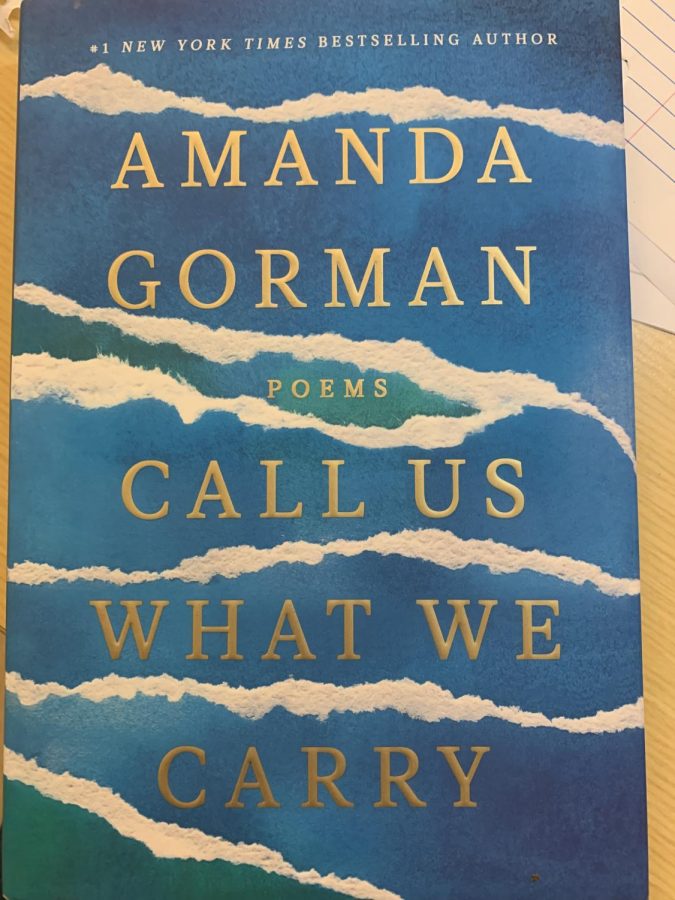Review: Call Us What We Carry by Amanda Gorman
Amanda Gorman, presidential inaugural poet, releases a new collection of poems.
May 5, 2022
“But perhaps it is we who make / Falsities of luminescence— / Our shadows playing tricks on stars.”
The first time I sat to truly read this collection of poetry, that line gave me pause.
From the poem titled “Lucent,” it ended up scribbled in cursive on a page of one of my three million notebooks, combining my favorite things into one beautiful sentence. It’s starry, and as many people can attest, I’m a sucker for space metaphors. But more than that, the poem is one about humans as humans, how perspective changes depending on where light is shed and how people can be seen as monsters.
I, like many and probably most, first heard of Amanda Gorman when she became the youngest inaugural poet in American history at 22, after she read her poem “The Hill We Climb” (the last poem in the book) at Joe Biden’s inauguration.
And then she became a sensation.
Catapulted into stardom, her schedule became booked overnight. Interviews were given with Oprah; she was on the cover of Vogue by May; she was signed to IMG Models.The red headband she wore at the inauguration sold out and searches for coats like that which she wore in her favorite color yellow increased by over 1,000%.
And this is her debut into the world of the published word.
On Zoom last year, my English teacher hit screen share to show us a video of her performance (because that’s how I can best describe her glittering delivery—a performance) and put a document in Schoology with the poem, allowing us to follow along with her intonation, the mountains and valleys of her voice as she read, “For there is always light, if only we’re brave enough to see it. / If only we’re brave enough to be it.”
I decided then and there that I wanted to read every piece she will ever write.
So when I saw her book for sale, I bought it immediately and let me tell you, she did not disappoint.
Flipping through the book on the way home, I found a section that caught my attention, and one of those first poems was “Roses.” The poem is one of the shortest, a twist of the known rhyme printed white on a near-black page: “Riots are red / Violence is blue / We’re sick of dying / How ’bout you.” Like many of the poems in this anthology, this is an allusion to gun violence and the Black Lives Matter movement. The riots that lend themselves to crimson red blood shed and the violence dealt at the hands of the police resulting in nothing but azure tears, just as rich as the blood, just as human.
There’s no clear solution, just unrest and dissatisfaction, people rendered unable to do anything about their daily injustices but garner empathy.
No one wants just empathy anymore. Now we need change,
and that is what most of the poems are underscored by: change.
I found lots of the poems in the book were focused on the pandemic, and analyzing how it has changed us. The first two sections of the book, “Requiem” and “What A Piece of Wreck is Man,” focus on the loneliness, survival, grieving the loss of both lives and living, and the concept of how quarantine brought us a clearer view of ourselves. In “Requiem” it says, “There is no meek way to mend. / You must ruin us carefully,” while “What A Piece of Wreck is Man” explores different descriptions of humans, including the titular line in “Call Us,” which calls people “A boat of a being” for all the bacteria that lives in and on our bodies. “In the Deep” is similar, calling back to the line “Call us / What we carry” with “Say it plain. / Call us who we left behind.” A poem in this section titled “Essex I” is about the tragedy of a whaling ship attacked by a sperm whale which details how we become what we fear, a study in man versus monstrosity.
“Earth Eyes” is the shortest section of the book at seven poems, speaking of climate change and comparing people to nature and Pandora’s box. The poem “Captive” is one of my personal favorites, comparing the behavior of animals in captivity to humans in isolation. The poem is interjected with brackets describing stereotypic behavior, such as the repetitive motions that characterize it and its normality in abnormal environments. The poem that lends itself to the section’s name, “Earth Eyes,” is formatted in the shape of an eye and describes how Gen Z is expected to fix climate change, if it is to be fixed at all.
Many of the poems are erasure poems (pre-existing text that is strategically erased in a way to create poetry), which Gorman uses to expose underlying meanings in her poem “Erasure.” “Donohue Family Ledgers” is an example of this, taken from one Michael Donohue on the records of his family’s funeral home during the 1918 influenza pandemic. It reads: “Scribbled at the bottom / This ‘girl’, / ‘This girl was buried in the trench.’ / This girl was our trench. / Where else to put her.”
“Fury and Faith” is a fitting almost-end to the book, giving commentary on the importance of the Black Lives Matter movement and touching on the abundance of school shootings in America. “The Truth In One Nation” explores what the truth of America is, behind the allure of grandeur, and includes such lines as, “R.I.P. / Ravaged In Pandemic. / Rifled Innocent People. / Razed Irreplaceable Persons. / Look alive, everyone.” This poem sees the pages turn from black back to cream as it starts with brutal honesty and ends on a fragile note of hope for change.
And that brings us to the finale: “Resolution.” This section is essentially the aftermath of the pandemic and a culmination of the past two years. “The Miracle of Memory” is one of the few poems in the collection that rhymes and stands out because of its hope. It’s a bright day in quarantine, a looking back on a time that we expected to be bad, knowing that everything eventually turned out alright. “Monomyth” puts the events of 2020 through July 2021 into the perspective of a story, days listed as scenes. “What We Carry” is the second-to-last poem, continuing the ark and nautical metaphors that we see weaved throughout, because throughout quarantine we all pretended we were in the same boat, and in some ways, we were.
This poem brings back the ponderings present in “Requiem,” saying that we carry “What & who we care most for.” We carry hate and hubris and all the things that make us monsters, but we are also full without them.
We also carry the love and hope that makes us human.
So call us that, our overpowering goodness over all the bad. Call us what we carry.
All things considered, I loved this chronicling of loneliness, the way she uses still-unprocessed trauma to make art, using history and etymology combined with our present lives to weave verse. She has a way of making her thoughts readily available, complicated and drenched in meaning but not inaccessible, just enough to make you really think and contemplate.
A near-perfect poet at 23, the story of her talent is just beginning to unfold. And just like when I first heard her insightful cadence, I can’t wait to see what she does next.

